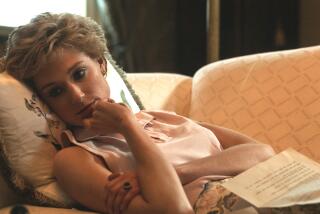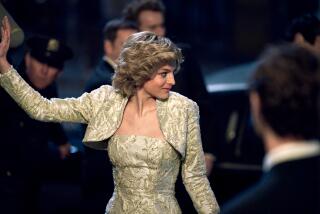Arrival of Fun-Loving Fergie Forever Changed Diana’s Life
- Share via
In just two years, from 1984 to 1986, Princess Diana dramatically transformed herself from a shy, awkward young princess into a confident, dashing young woman who would win praise from fashion experts around the world for her poise, elegance and style.
It was almost certainly the arrival of Sarah Ferguson on the royal scene that gave Diana a radically different perspective on life.
Fergie’s confidence began to rub off on Diana. More important, she helped Diana to relax and enjoy herself for the first time in her married life. Fergie had always had fun, whether at school, parties, balls, dinner parties or restaurants. She enjoyed life to the fullest and decided nothing was going to change because she was to marry a prince.
Her zest for life was infectious. Diana started to love the excitement and stimulation Fergie brought to her life.
Because of her friendship with brash, effervescent Fergie, at a time when she was beginning to see that her once adored husband was not perfect and could not give her everything she craved, Diana reached a turning point in her life. She had Fergie to thank for the change in her attitude toward her husband and her way of life--a change which was to shake and almost undermine her marriage, worry the queen and alarm the royal advisers.
Fergie’s existence made Diana do some hard thinking. She envied her friend’s independence and realized that she, too, had a life of her own to lead. Her youth was slipping by. She had met Charles when she was very young, and hardly had time to enjoy the carefree teen-age years before she was saddled with the yoke of royal protocol.
Diana began to realize that the time had come for her to start enjoying life. She was 25 years old and needed to cast aside her feelings of immaturity and nervousness.
Fergie introduced her to a younger set of women who brought along their boyfriends. These young men were perhaps five or 10 years younger than Charles, and Diana realized that she was enjoying herself in their company. There was no heavy conversation that she couldn’t understand, as there so often was at Kensington Palace dinner parties. These people made no demands on her intellect; she could just chat away about trivia. Nobody took anything very seriously. Diana could now act like a young woman. She could laugh and have the type of fun she had all but forgotten was possible after her marriage into the royal family five years earlier. And she could crack her own little jokes and get a laugh in return, instead of the icy looks from around the royal dinner table that often greeted her attempts to lighten the conversation.
These young men and women were full of vitality. Their dinner parties were noisy, funny and argumentative, so different from the boring, protocol-ridden dinner parties Diana had become used to with Charles and his conservative friends.
It was Fergie who brought Diana back out into the world she had once enjoyed. Fergie and Prince Andrew loved to go out together to cocktail or dinner parties and joke around, even drink a little too much. One reason Andrew was attracted to Fergie was that she always seemed to enjoy life and have a smile on her face.
At one evening cocktail party in the summer of 1985, Diana, Andrew, Fergie and 20 or so other young people had gathered. The evening was going swimmingly when the phone rang. It was the queen.
The hostess shouted, “Andrew, it’s your mother on the phone.”
“What the hell does she want?” he asked in a loud voice.
“I don’t know. I’ll ask,” came the reply.
A second or two later the hostess shouted, “She wants to know whether you will be home for dinner tonight.”
Andrew called to her above the noise of the conversation, “Tell her no. I’m out enjoying myself.”
He turned to the group around him, which included Diana and Fergie, and said, “If she thinks I’m going back to a boring old dinner at the palace she’s in for a shock.” Diana roared with laughter.
Diana started to enjoy alcoholic drinks, something she’d rarely done before. She started to unbend and forget the rules of etiquette which had been drummed into her by Charles and the royal advisers. She cast off her inhibitions and behaved like a normal, decidedly unroyal, person. She was no longer confined by the restrictions and protocol of Kensington Palace, and the need to keep up appearances in front of the staff.
The more she socialized with her new set of friends, the more she realized the difference between her husband and the dashing young men she met. She realized she had far more in common with these young profligates, whose idea of a good time was to laugh boisterously and throw bread rolls at each other in a restaurant or drink too much bubbly. Anything but serious conversation.
Charles and Diana started having more rows. Diana was determined to continue her newfound, hedonistic life, and damn the consequences.
In 1985 Diana confessed to a royal friend that she was decidedly fed up with the strictures Charles was trying to impose on her. “So what if he doesn’t approve?” she said. “So what if he thinks my conduct is unseemly for Her Royal Highness the Princess of Wales? For once I am having fun, and all Charles can do is to try and dampen my spirits and make my life miserable. Well, I’m not going to let him.”
How the tables had turned. Early in their married life, Diana had been angry when Charles left her at home and went off hunting, shooting or playing polo. Now it was Charles who was angry. He wanted his wife to stay home in the evening instead of going off with Fergie and her friends to dinner parties.
Diana, Fergie, the blond Australian comedienne Pamela Stephenson, and Renate, Elton John’s former wife, often used to go out together to friends’ houses for dinner. Diana was even beginning to develop her own repertoire of jokes and party pieces. Those around her always appreciated Diana’s humor, perhaps because she was the princess of Wales. Some found her jokes rather juvenile, but they were always received with loud laughter, which Diana loved. It made her feel like one of the party. She was wanted by the friends she was desperate to keep.
In fact, she earned a reputation for making rather naughty, even sexy, jokes. In December Diana sent at least a couple of naughty, rude “Christmas cards” to close friends.
Nor did anyone know to whom Diana was going to send two naughty stocking-fillers when, in 1991, she went to a joke shop in London’s crowded Oxford Street and bought two adult gag toys.
Charles disapproved of her behavior but was powerless to do anything about it. If he complained, Diana would tell him not to be an old fuddy-duddy. He should try to let himself go and enjoy life, as she was. The more Diana went her own way with her best friend Sarah, the more Charles disapproved.
Charles could not tolerate Diana’s boisterous behavior and made no effort to hide his contempt. During the first three years of their marriage, Diana had hero-worshipped Charles and wanted to please him. Charles had once been her mentor, teaching her how to behave and how to become an acceptable member of the royal family. Now he was no longer the most dominant person in her life, and Charles was having problems coming to terms with this.
The shy teen-ager he had first fallen for was gone forever. That Diana--who had squirmed with embarrassment, blushing to the roots of her blond hair when a speechmaker declared in her presence she was “more beautiful than Cleopatra, Queen of the Nile”--was, like the fabled monarch, a creature of the past. Now that she had produced not one but two heirs, she felt she had done her duty to Charles and the queen. Now she was going to do what she wanted. Charles didn’t know how to respond to this new, confident, headstrong woman. He didn’t know what to do about the crisis that had engulfed not just his marriage, but his whole life.
He had desperately wanted a happy, trouble-free marriage. But in his search for a young, untrained bride, Charles had been swept off his feet. His ego had been boosted by the beautiful young teen-ager who was so plainly in love with him. The marriage he had planned for so long had disintegrated into a marriage of convenience, exactly what he had feared would happen. He knew he had to find a way out of the mess he was in and to take charge of his life again. He didn’t know how.
Diana, meanwhile, knew exactly where the marriage was heading--for the rocks. She had spurned her husband, the prince of Wales and heir to the throne, and usurped his position as the nation’s favorite royal. She now realized that she could behave very much as she liked and get away with it. The fact that the marriage hadn’t worked did not mean her life was going to end there. She had her two sons, her charity work and her looks, and she was determined to enjoy her position, her privileges and her power.






